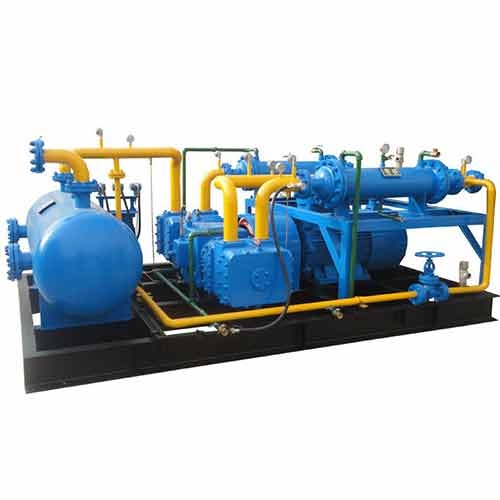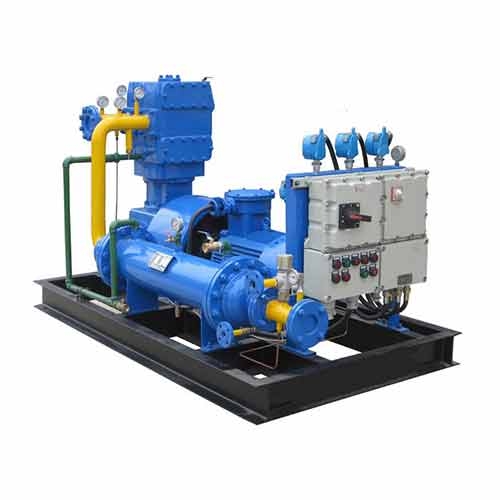The Power and Efficiency of Reciprocating Natural Gas Compressor
What does it mean to have a reciprocating natural gas compressor?
A reciprocating natural gas compressor is mechanical equipment that raises natural gas pressure by compressing the gas in a back-and-forth motion. Natural gas transportation, storage, and distribution are only a few uses for this kind of compressor in the natural gas business.
The Strength and Effectiveness of Reciprocating Natural Gas Compressors:
Reciprocating natural gas compressors are essential to the distribution, transport, and production of natural gas in several sectors. They raise natural gas pressure, allowing for effective pipeline transmission, reservoir storage, and other uses. Several variables, including design, operational circumstances, maintenance, and technology developments, influence reciprocal natural gas compressor performance and efficiency. A summary of their power and efficiency concerns is given below:
1. Power:
Horsepower (HP) or kilowatts (kW) describe a reciprocating natural gas compressor. The amount of gas being compressed, the intended discharge pressure, and the compressor’s efficiency all affect how much power the compressor needs. Gas must be compressed to build pressure by breaking through the gas molecules’ resistance. The more power is needed, the greater the pressure and flow rate.
2. Effectiveness:
The effectiveness of a reciprocating compressor in converting the input power into the required output pressure and flow rate is referred to as efficiency. Efficiency is important when using compressors since better efficiency reduces running costs and energy usage. A number of factors influence the effectiveness of reciprocating natural gas compressors:
- Compression Ratio:
The compression ratio is the ratio of the release compression to the force compression. Due to greater heat generation during compression, higher compression ratios often result in lesser efficiency.
- Clearance Volume:
The clearance volume is the area that exists when the piston is at the peak of its stroke between the piston and the cylinder head. By reducing the volume of gas that is trapped in the cylinder, a lower clearance volume increases efficiency.
- Mechanical and Thermal Efficiency:
The compressor’s capacity to transform input power into mechanical work without losses is mechanical efficiency. How well the compressor controls heat produced during compression is called thermal efficiency. High thermal efficiency must always be maintained, which calls for effective cooling and heat dispersion techniques.
- Valve Efficiency:
Reciprocating compressors employ valves to regulate gas flow into and out of the cylinder. Maintaining optimal compressor performance depends on efficient valve design and operation.
- Materials and Lubrication:
The efficiency of a compressor’s lubrication system and the material selection for its parts both has an impact. Appropriate materials and lubricants are crucial since friction and wear can limit efficiency.

- Cylinder Configuration:
Efficiency can be impacted by a cylinder’s configuration, such as whether it is single-stage or multi-stage. Multi-stage compressors are frequently utilized to attain greater efficiency for higher pressure ratios.
The Performance of Reciprocating Natural Gas Compressors and Their Optimization:
Reciprocal natural gas compressor performance and optimization are crucial factors that affect their effectiveness, dependability, and operating costs. To achieve the best compressor performance, engineers and operators concentrate on a variety of aspects. The performance and optimization factors for reciprocating natural gas compressor is described in greater depth below:
- Key Performance Parameters:
- The amount of gas the compressor can handle in one unit of time is known as the flow rate. It’s critical to balance the compressor’s capacity with the necessary flow rate to avoid overloading or underuse.
- The pressure at which the gas is released from the compressor is known as the discharge pressure. The compressor must be configured and run properly to produce the necessary discharge pressure for the particular application.
- The quantity of electrical power or energy needed to run the compressor is known as power consumption. For the operation to be cost-effective, lower power consumption is preferred.
- Optimization Techniques:
Several techniques are used to enhance the performance of reciprocating natural gas compressors:
- Selecting a compressor with the appropriate capacity and configuration for the particular application assures effective operation. Compressors that are too big or too little might save energy and provide sufficient compression.
- This technique is employed when a high-pressure ratio is necessary. To do this, the gas must be compressed in stages, each with its cylinder. This strategy increases effectiveness while minimizing damage.
- The configuration of the cylinders (in-line, V-type, etc.) impacts mechanical loads and efficiency. By choosing the best cylinder configuration, vibration is reduced, and efficiency is increased.

- Intake and discharge valve design and maintenance are essential. Gas flow dynamics, efficiency, and dependability are impacted by valve design.
- Modern automation and control systems make the exact control of compressor operations possible. Utilizing variable frequency drives (VFDs), the compressor motor’s speed may be changed to better match output to demand and increase efficiency.
Applications requiring a wide variety of pressure ratios and flow rates are ideally suited for reciprocating compressors:
They are frequently employed in the natural gas sector for tasks like:
- Gas Transmission:
Compressors are used to increase natural gas pressure so that it may be transported through pipes over large distances more effectively.
- Gas Storage:
Underground reservoirs store compressed gas for later use or maintain the gas supply during periods of high demand.
- Gas distribution:
Compressors assist in keeping local distribution networks under pressure, guaranteeing a consistent supply for customers.
- Gas processing:
These compressors aid in the movement of gas through several phases of treatment and purification in processing facilities.
Conclusion:
For reciprocating natural gas compressor, efficiency and power must coexist. The efficiency with which these compressors can raise natural gas pressure while reducing energy consumption and running costs depends on various factors, including design considerations, operating circumstances, and technical advancements. We provide benefits in terms of adaptability, flexibility, and efficiency to various pressure needs. HUAYAN is committed to meeting the demands of our clients. It is reduce all expenses for our clients, to reduce all expenses for clients.
